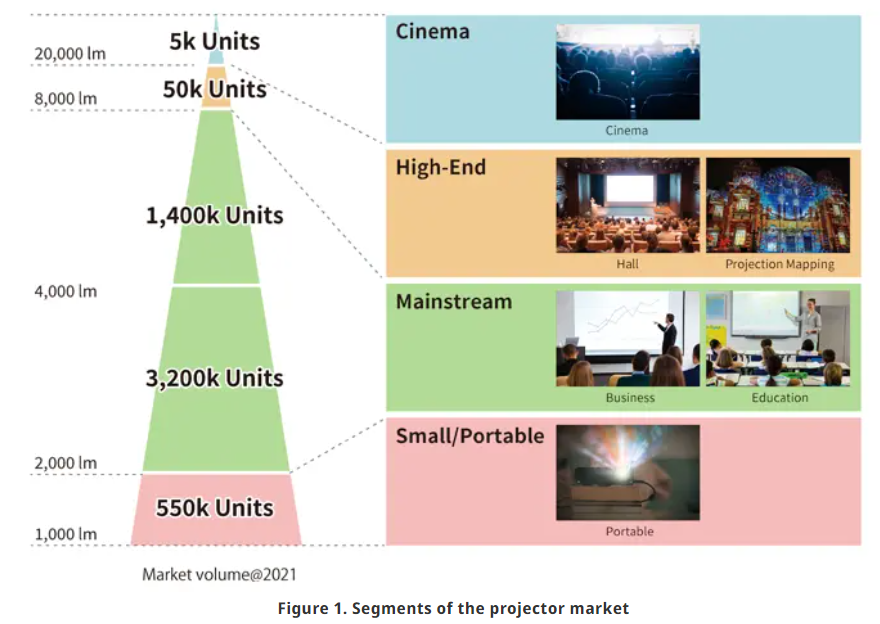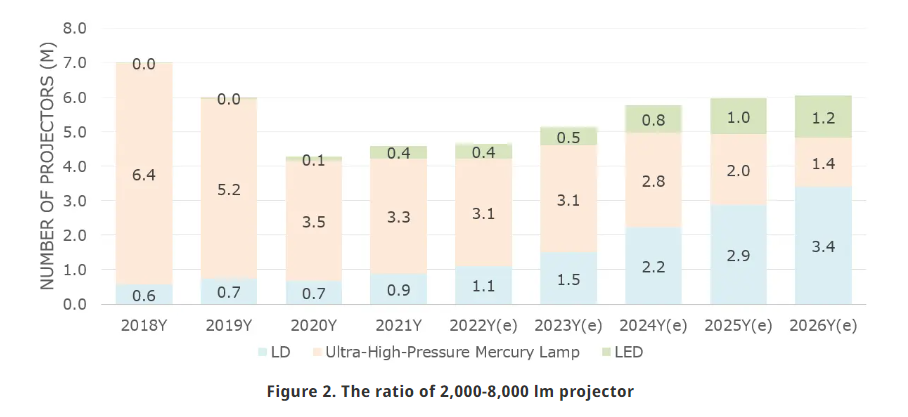Projectors are commonly used in meetings and seminars, and their primary light source is still ultra-high-pressure mercury lamps. As the name implies, ultra-high-pressure mercury lamps contain mercury and generate concerns regarding environmental pollution. For that reason, they are expected to be replaced by solid-state light sources which do not contain mercury such as LDs (Laser Diodes) and LEDs. However, due to cost and other reasons, this replacement is taking time, and in the RoHS Directive, ultra-high-pressure mercury lamps for projectors with an output of ≥2,000 lm can be manufactured and sold under an exemption at least until 2027.
LDs and LEDs are new technologies. Looking back in history, in 1993, Nichia started the mass production of the world's first high brightness blue LED. Utilizing this technology, violet LDs were developed and started mass production in 2001. The world's first solid-state light source projector using blue LDs, which were developed next, was launched in Japan in 2010, just over a decade ago. Since it is a new technology, its technical progress is constantly evolving.
When the research that became the basis for the decision to exempt them from the RoHS until 2027 was conducted a few years ago, it may have been difficult to replace ultra-high-pressure mercury lamps entirely and immediately. However, as of today, projectors using LD/LEDs as light sources account for 35% of total product shipments (Data: Nichia's estimated volume in 2021), and this percentage is increasing rapidly every year.
Below explains the projector market (Figure 1) /ratio of the LD adoption for each segment and the status of the light sources.

Cinema
In the movie theaters and other venues, projectors with ≥20,000 lm have been used. LD light sources are highly efficient and save electricity costs, and their longer lifetime dramatically reduces the light source replacement frequency. In addition, they can achieve high color reproducibility and high contrast. Through these advantages, LD already accounts for more than 90% in terms of shipments.
High-End
As for 8,000-20,000 lm projectors used in event halls and for projection mapping, more than 90% of these types of projectors have been switched to LD light sources for several reasons, including long lifetime.
Mainstream
Mainstream projectors have a 2,000-8,000 lm output and they are used in meeting rooms and in educational settings. The percentage of LD light sources in this category is still around 30%, which is lower than that of cinema and high-end projectors. However, this percentage is increasing year by year through the numerous advantages of LD, as explained below, combined with cost reductions resulting from market expansion (Figure 2).
The benefits of LD light sources
-
Long lifetime reduces the frequency of the maintenance and replacement of the light source:While the lifetime of ultra-high-pressure mercury lamps is 3,000h~6,000h, the standard lifetime of an LD light source is about 20,000h. This makes it possible to operate without maintenance for a long period of time. Reducing the frequency of light source replacement can lead to lower costs, less waste containing hazardous mercury, and environmental conservation.
-
High luminance and energy saving:LD light sources have extremely high luminance, enabling projectors to produce brighter images with less power, thereby improving energy efficiency.
-
Emit light instantly:LD light sources light up instantly and reach maximum brightness immediately. This allows the projector to start up and display images quickly. Since the warm-up time required by ultra-high-pressure mercury lamps is no longer necessary, LD light sources are more convenient in situations such as meetings and events.

Small/Portable
The Small/Portable segment is a market designed on the premise of the advantages of miniaturization in solid-state light sources due to the compact size of LD/LED light sources. Ultra-high-pressure mercury lamps are not used at all, and LEDs make up the majority in terms of the number of light sources.
As mentioned above, in most segments, ultra-high-pressure mercury lamps have already been or are being replaced by LDs or LEDs, and Nichia believes that for projectors, a major trend toward mercury-free for the light source has already been established. To ensure that LDs will be firmly positioned as an alternative technology to ultra-high-pressure mercury lamps for projectors, and that the extension of the RoHS exemption beyond 2027 will no longer be necessary, Nichia will continue efforts to improve the characteristics of the products, focusing on efficiency, and make proposals that will lead to further adoption in this segment.













